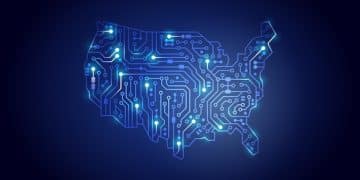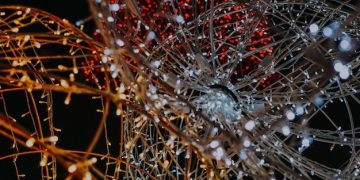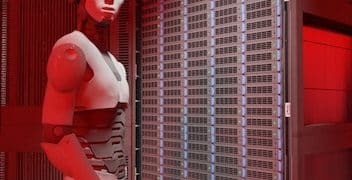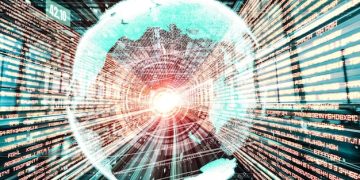Quantum Computing & US Cybersecurity: 2025 Impact Explored
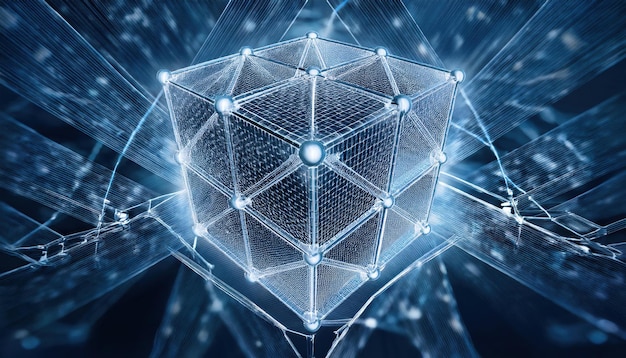
Quantum computing is poised to fundamentally redefine US cybersecurity by 2025, presenting both unprecedented threats to current encryption through advanced computational power and offering revolutionary new defenses against sophisticated cyberattacks.
The dawn of quantum computing represents a pivotal moment for technology, promising breakthroughs across various sectors, from medicine to finance. However, its immense computational power also casts a long shadow over existing security paradigms, particularly how will quantum computing impact US cybersecurity by 2025. This technology’s ability to process complex calculations at speeds currently unimaginable means that the cybersecurity landscape, as we know it, is on the precipice of a dramatic transformation.
The Quantum Leap: Understanding the Basics for Cybersecurity
To grasp the profound implications of quantum computing, it is essential to understand its fundamental principles, particularly how they differ from classical computing. Unlike traditional computers that store information as bits (0s or 1s), quantum computers use qubits, which can represent 0, 1, or both simultaneously through superposition. This seemingly simple distinction unlocks immense processing power.
Another core concept is entanglement, where two or more qubits become linked, sharing the same fate even when physically separated. This allows quantum computers to perform multiple computations at once, leading to an exponential increase in processing capability. For cybersecurity, this means the potential to break current cryptographic standards, which rely on the difficulty of factoring large numbers or solving complex mathematical problems—tasks classical computers struggle with but quantum systems could effortlessly overcome.
Superposition and Entanglement
Superposition allows a qubit to exist in multiple states concurrently. This is akin to a coin spinning in the air, simultaneously showing heads and tails until it lands. Entanglement, on the other hand, creates an instantaneous connection between qubits, no matter the distance.
- Superposition: Enables simultaneous exploration of multiple solutions.
- Entanglement: Links qubits for coordinated, rapid processing.
- Parallel Computation: Quantum computers can test many possibilities at once.
- Exponential Power: Adding more qubits roughly doubles processing power.
The rapid advancements in quantum hardware, even by 2025, suggest that rudimentary but powerful quantum machines could begin to pose real threats. While a fully fault-tolerant quantum computer capable of breaking all public-key cryptography might still be years away, the “harvest now, decrypt later” threat is very real. Adversaries could collect encrypted data today, intending to decrypt it once quantum computers are sufficiently powerful.
Understanding these quantum mechanics is the first step in preparing for the quantum age of cybersecurity. It moves beyond abstract scientific concepts to practical implications that will directly affect data security, encryption protocols, and national defense strategies.
Immediate Threats: Quantum Computing’s Impact on Current Encryption
The most immediate and widely discussed threat quantum computing poses to cybersecurity lies in its potential to break current cryptographic standards. Algorithms like Shor’s algorithm, if run on a sufficiently powerful quantum computer, could efficiently factor large numbers, thereby undermining RSA and Elliptic Curve Cryptography (ECC)—the foundational pillars of modern asymmetric encryption.
RSA and ECC are used worldwide to secure everything from online banking and e-commerce transactions to government communications and critical infrastructure. Their security relies on the immense computational difficulty for classical computers to factor large prime numbers or solve discrete logarithm problems. A quantum computer, however, could solve these in polynomial time, rendering these protections obsolete.
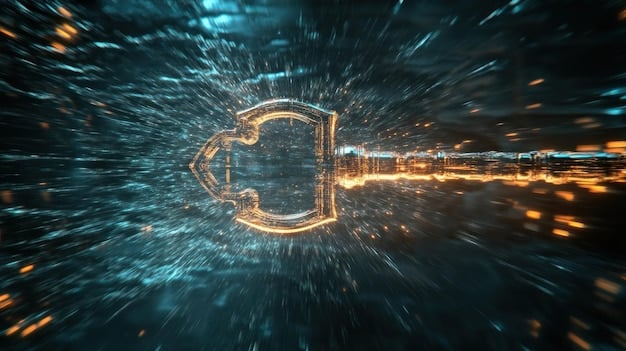
Vulnerability of Public-Key Cryptography
The implications for public-key cryptography are profound. Imagine a world where all encrypted communications, past and present, could be decrypted by an adversary. This would expose sensitive government secrets, financial transactions, personal data, and intellectual property.
- RSA and ECC: Directly targeted by Shor’s algorithm.
- Digital Signatures: Could be forged, impacting trust and authentication.
- Key Exchange: Protocols like Diffie-Hellman would be compromised.
- Data Breaches: Retrospective decryption of previously intercepted data.
The timeline for this quantum threat is subject to debate, but many experts agree that by 2025, while not a fully mature threat, the groundwork for quantum-safe transitions must be firmly in place. The National Institute of Standards and Technology (NIST) has been actively working on standardizing post-quantum cryptography (PQC) algorithms, a clear acknowledgment of the impending danger.
Furthermore, Grover’s algorithm poses a threat to symmetric encryption (like AES) and hash functions. While it doesn’t break them entirely, it reduces the effective key length by half. This means a 256-bit AES key would effectively become as secure as a 128-bit key, requiring an upgrade to larger key sizes to maintain current security levels. The cumulative effect of these algorithmic threats means that virtually all layers of current cybersecurity stand to be impacted, necessitating a comprehensive shift in how we approach data protection.
The Dawn of Post-Quantum Cryptography (PQC)
In response to the quantum threat, the cybersecurity community is rapidly developing and standardizing post-quantum cryptography (PQC). PQC refers to cryptographic algorithms that are secure against attacks by sufficiently powerful quantum computers, as well as classical computers. The goal is to replace or augment existing public-key algorithms with new ones that resist quantum attacks.
NIST has been at the forefront of this effort, launching a multi-year process to solicit, evaluate, and standardize PQC algorithms. Several candidates have emerged, categorized by the mathematical problems they rely on, such as lattice-based cryptography, code-based cryptography, multivariate polynomial cryptography, and hash-based cryptography. These new algorithms aim to ensure the continued confidentiality, integrity, and authenticity of digital communications in the quantum age.
NIST’s Standardization Efforts
The standardization process is rigorous, involving extensive peer review and cryptanalysis. By 2025, the initial set of standardized PQC algorithms is expected to be finalized, providing a crucial roadmap for organizations to begin their transition. This transition, often referred to as “crypto-agility,” involves preparing systems to swap out vulnerable algorithms for quantum-resistant ones without significant disruption.
- Lattice-based cryptography: Strong candidates like CRYSTALS-Dilithium and CRYSTALS-Kyber.
- Code-based cryptography: Algorithms such as McEliece.
- Hash-based signatures: For specific use cases like firmware updates due to fast processing.
However, the implementation of PQC is not a trivial task. It requires significant investment in research, development, and deployment. Organizations will need to inventory their cryptographic assets, identify vulnerabilities, and develop migration strategies. By 2025, many US agencies and critical infrastructure operators are expected to be well into the planning and early implementation phases of PQC, recognizing the urgency of this transition.
The challenges extend beyond technical implementation to encompass public awareness, regulatory support, and the coordination of a global cryptographic upgrade. The success of PQC adoption will depend on collaborative efforts between government, industry, and academia to ensure a secure transition into the quantum era.
Quantum-Resilient Architectures and Strategies
Beyond simply swapping out algorithms, the advent of quantum computing necessitates a rethinking of entire cybersecurity architectures and strategies. This transition, often termed a “cryptographic migration,” is far more complex than a simple software update. It involves identifying every instance of vulnerable cryptography, assessing risk, and implementing quantum-resistant solutions across diverse systems.
One key strategy is “hybrid mode” implementation, where both classical and post-quantum algorithms are run in parallel. This provides a safety net during the transition phase, ensuring that security is maintained even if early PQC algorithms are later found to have weaknesses. Organizations will need to develop comprehensive crypto-agility frameworks, enabling them to quickly adapt to new cryptographic standards as they evolve.
Building for the Future
System architects will increasingly design networks and applications with quantum resilience in mind. This includes adopting secure boot mechanisms, hardware-level security, and zero-trust architectures that minimize reliance on perimeter defenses vulnerable to advanced attacks. By 2025, conversations about “quantum-proof” infrastructure will move from theoretical discussions to practical blueprints.
- Crypto-Agility: The ability to rapidly swap cryptographic primitives.
- Hybrid Deployments: Running classical and PQC algorithms simultaneously.
- Quantum Key Distribution (QKD): Explored for highly secure communication channels.
- Hardware Security Modules (HSMs): Upgraded for PQC support.
Another area of focus is Quantum Key Distribution (QKD). While not a full cybersecurity solution on its own, QKD offers an intrinsically secure method for exchanging cryptographic keys, leveraging the laws of quantum physics to detect eavesdropping. While its practical deployment is limited by distance and infrastructure costs, research and development in QKD will continue, with potential niche applications in highly sensitive government or military communications by 2025.
The US government, particularly agencies involved in national security and critical infrastructure, will likely prioritize this cryptographic modernization. This proactive stance is crucial, as the cost of a successful quantum attack on sensitive data could be catastrophic. Strategic investments in quantum security research and development, coupled with public-private partnerships, will be vital to building robust, quantum-resilient cybersecurity defenses.
The Geopolitical Race for Quantum Supremacy
The development of quantum computing capabilities is not merely a technological race; it is a geopolitical competition with profound national security implications. Nations recognize that achieving “quantum supremacy”—the ability of a quantum computer to solve problems that no classical computer can practically solve—could confer significant strategic advantages, particularly in areas like cryptography, intelligence, and defense.
The US, China, and several European nations are heavily investing in quantum research, vying for leadership in this nascent field. This competition fuels rapid advancements, but also raises concerns about potential “quantum arms races.” The nation that first develops a large-scale, fault-tolerant quantum computer capable of breaking current ciphers would gain an unprecedented intelligence advantage.
National Security Implications
By 2025, while full quantum supremacy might still be elusive, the geopolitical implications will be acutely felt. Nations will be scrutinizing each other’s progress, safeguarding their own quantum research, and potentially engaging in cyberespionage to gain insights into rivals’ quantum programs. The race is as much about protecting one’s own data as it is about potentially exploiting an adversary’s vulnerabilities.
- Intelligence Gathering: Decrypting adversaries’ communications.
- Economic Espionage: Accessing sensitive industrial and trade secrets.
- Military Advantage: Enhancing defensive and offensive cyber capabilities.
- Strategic Deterrence: The perceived ability to break any code.
The US government, through agencies like the National Security Agency (NSA) and the Department of Defense (DoD), is actively tracking these developments and planning for their impact. Ensuring the security of classified information and critical infrastructure against quantum attacks is a top priority. This involves not only developing defensive PQC measures but also understanding potential offensive quantum capabilities.
International cooperation on PQC standards will be vital to prevent fracturing the global cryptographic landscape, but true collaboration might be hampered by national security interests. The geopolitical dynamics surrounding quantum computing will shape cybersecurity policies, research funding, and strategic alliances in the coming years, making 2025 a critical milestone in this evolving landscape.
Preparing the Workforce and Policy Landscape
The transition to quantum-safe cybersecurity is not solely a technological challenge; it also demands a significant transformation in workforce skills and policy frameworks. By 2025, the demand for professionals with expertise in quantum computing, post-quantum cryptography, and quantum-resilient systems will far outstrip supply.
Educational institutions and industry leaders must collaborate to develop curricula that train the next generation of cybersecurity experts in these specialized fields. This includes cryptographers, quantum physicists, software engineers, and IT administrators capable of understanding, implementing, and managing quantum-proof systems. Reskilling and upskilling existing professionals will also be crucial.
Policy and Regulatory Frameworks
Governments, particularly in the US, will need to establish clear policy and regulatory frameworks to guide the quantum transition. This includes mandating PQC adoption for critical infrastructure, defining standards for data protection in the quantum age, and allocating resources for research and development.
- Workforce Development: Training in PQC, quantum mechanics, and resilient architectures.
- Government Mandates: Directing federal agencies and critical sectors to adopt PQC.
- International Collaboration: Aligning PQC standards globally to avoid fragmentation.
- Resource Allocation: Funding for R&D and implementation.
By 2025, we can expect to see more specific directives from agencies like NIST and the Cybersecurity and Infrastructure Security Agency (CISA) on PQC migration paths. These policies will aim to ensure a coordinated and timely shift, minimizing the window of vulnerability. Legislative efforts might also emerge to address potential liabilities related to quantum-induced data breaches.
Furthermore, international policy discussions will become more prominent, as cybersecurity is a global issue. Harmonizing PQC standards and sharing best practices across borders will be essential, though challenging given the geopolitical competition. Preparing the workforce and crafting agile policy frameworks are foundational non-technical steps that must accelerate rapidly by 2025 to meet the quantum challenge effectively.
Ethical Considerations and Future Prospects
As quantum computing advances, so too do the ethical considerations surrounding its use, particularly in the realm of cybersecurity. The power to break most existing encryption could be wielded for both good and ill. Ensuring that quantum technology is developed and deployed responsibly becomes a paramount concern for governments, researchers, and corporations alike.
One major ethical challenge is the potential for increased surveillance. If quantum computers can decrypt vast amounts of historical and real-time data, the line between legitimate intelligence gathering and mass surveillance could become blurred. The balance between national security and individual privacy will be constantly re-evaluated in the quantum age.
Responsible Development and Safeguards
By 2025, discussions around ethical AI and responsible quantum development will gain more traction. International agreements or norms might begin to emerge, aiming to prevent the weaponization of quantum computing capabilities. Safeguards, such as quantum-secure multi-party computation and homomorphic encryption, could offer new ways to process sensitive data without exposing it.
- Privacy Concerns: Risk of widespread decryption of personal data.
- Surveillance Capabilities: Enhanced ability for state actors to monitor communications.
- “Weaponization” Prevention: Calls for responsible research and non-proliferation.
- Beneficial Applications: Quantum-enabled fraud detection and secure voting systems.
Looking beyond 2025, quantum computing also offers revolutionary prospects for cybersecurity. While it poses threats to current encryption, it also provides the potential for entirely new forms of security. Quantum machine learning could vastly improve anomaly detection, identifying sophisticated cyberattacks that evade classical systems. Quantum supremacy might lead to breakthroughs in secure multi-party computation, allowing multiple entities to jointly compute on sensitive data without revealing their individual inputs.
The journey into the quantum era of cybersecurity is complex, fraught with challenges but also brimming with opportunities. By 2025, the initial shifts will be underway, requiring careful navigation through ethical dilemmas and proactive investments in both defensive and potentially beneficial quantum technologies to secure the digital future.
| Key Point | Brief Description |
|---|---|
| ⚛️ Quantum Threat | Quantum computers can break current encryption (RSA, ECC), enabling data decryption by 2025. |
| 🛡️ Post-Quantum Crypto | NIST is standardizing new algorithms (PQC) resistant to quantum attacks. |
| 🏗️ System Redesign | Cybersecurity architectures must shift to quantum-resilient designs and hybrid modes. |
| 🌍 Geopolitical Race | Nations are competing for quantum supremacy, impacting global security and intelligence. |
Frequently Asked Questions About Quantum Cybersecurity
While a fully fault-tolerant quantum computer capable of breaking all encryption might not be widely available by 2025, the threat will be in its early stages. Adversaries could be collecting encrypted data now, intending to decrypt it later once quantum capabilities mature. The “harvest now, decrypt later” scenario is a significant concern for sensitive data.
Post-Quantum Cryptography (PQC) refers to new cryptographic algorithms designed to be secure against both classical and quantum computing attacks. NIST is currently leading the standardization of these algorithms, which are based on mathematical problems that even quantum computers cannot efficiently solve. PQC aims to replace or augment existing vulnerable encryption methods.
US agencies, particularly those involved in national security and critical infrastructure, are actively preparing by funding PQC research, collaborating with NIST on standardization, and developing migration strategies. They are assessing their cryptographic inventory, implementing crypto-agility frameworks, and exploring quantum-resilient architectures to protect sensitive data and systems.
Crypto-agility is the ability of an organization’s systems and infrastructure to rapidly and seamlessly switch between different cryptographic algorithms. In the quantum era, this means being prepared to swap out classical, quantum-vulnerable algorithms for new post-quantum cryptographic ones without extensive downtime or major system overhauls. It’s crucial for adapting to evolving threats.
Yes, quantum computing has the potential to significantly enhance cybersecurity in several ways. It can lead to breakthroughs in quantum machine learning for advanced threat detection and anomaly identification. Quantum Key Distribution (QKD) offers intrinsically secure communication channels. Future quantum algorithms could enable new forms of secure computation, such as privacy-preserving data analysis.
Conclusion
By 2025, quantum computing will undoubtedly have begun to reshape the US cybersecurity landscape. While a fully realized quantum attack on widespread encryption may still be a few years away, the foundational shifts will be in motion. The imperative to move to post-quantum cryptography will accelerate, demanding significant investment in research, workforce development, and strategic infrastructure upgrades. The geopolitical race for quantum supremacy will intensify, making proactive national cybersecurity measures more critical than ever. The impact of quantum computing extends beyond mere technological upgrades, compelling a fundamental re-evaluation of how we secure our digital world against both unprecedented threats and novel opportunities.
